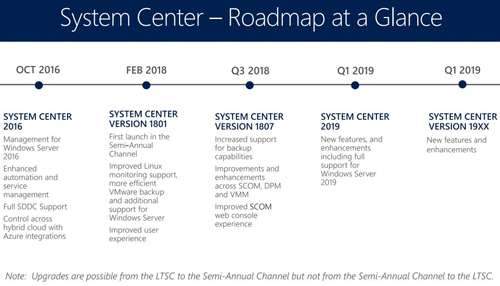News
Microsoft Issues New System Center 'Semiannual Channel' Release
- By Kurt Mackie
- July 25, 2018
Version 1807 of System Center, the management suite's latest semiannual channel update, became available from Microsoft on Tuesday.
There are currently two flavors of the System Center suite -- the semiannual channel product and the long-term servicing channel product -- that differ in product lifecycle support and the frequency of feature update releases.
The semiannual channel product gets biannually released feature updates, with each channel supported for 18 months (the one exception is the Configuration Manager component, which gets updated three times per year). The long-term servicing channel product gets updates every two to three years, with support following Microsoft's traditional "5 + 5" model (five years of "mainstream support" followed by five years of "extended support").
Roadmap
Microsoft first kicked off the semiannual channel update model for the System Center suite back in February when it released System Center version 1801. Tuesday's System Center version 1807 release is the second semiannual channel release of the product.
Microsoft's next big product release will be System Center 2019, which is expected to arrive in the first quarter of next year, according to Microsoft's roadmap document (PDF download):
 [Click on image for larger view.] System Center roadmap. (Source: Microsoft document)
[Click on image for larger view.] System Center roadmap. (Source: Microsoft document)
Updates
This release of System Center version 1807 isn't the full product build. It just includes what was updated. The updated components, per the announcement, include:
Organizations following the semiannual channel model have to apply System Center version 1807 on top of version 1801 to get the new capabilities.
Feature Improvements
Microsoft's announcement just highlighted improvements for two of the System Center version 1807 components.
For the Operations Manager component, Microsoft added a new PowerShell widget, which lets IT pros get and view customized data using PowerShell scripts. It also added HTML5 dashboard support, getting rid of a prior Silverlight dependency. Also new in Operations Manager is the ability to view the "effective configurations" or rules for any objects monitored. Microsoft also added a "log rotate" feature to Operations Manager that's designed to avoid running out of disk space when logging Linux server activities.
Other highlights were listed for the Virtual Machine Manager component. Virtual Machine Manager now has the ability to orchestrate the patching and updating of Storage Spaces Direct cluster nodes with the 1807 update. Microsoft also added the ability to select which cluster shared volume to use when adding a virtual hard disk (VHD). This latter feature is designed to avoid a problem where the VHD tends to stop if a cluster shared volume gets full.
Microsoft also added a few Hyper-V management enhancements to Virtual Machine Manager with version 1807. One of those enhancements will show the network connection details of Hyper-V hosts, such as "switch port ID, VLAN, chassis ID, management address of the switch, and other details," which can be used for troubleshooting purposes.
Another improvement is the ability to convert a Hyper-V switch into a logical switch. It facilitates deployments onto other Hyper-V hosts.
Microsoft also added more VMware support to this release of Virtual Machine Manager.
"SCVMM 1807 can now manage VMWare ESXi 6.5 hosts and supports conversion of VMs from this ESXi host to Hyper-V VMs," Microsoft's announcement explained.
Organizations can also improve the infrastructure support with the release of System Center version 1807. All components can now use SQL Server 2017 after upgrading from SQL Server 2016, Microsoft indicated.
About the Author
Kurt Mackie is senior news producer for 1105 Media's Converge360 group.